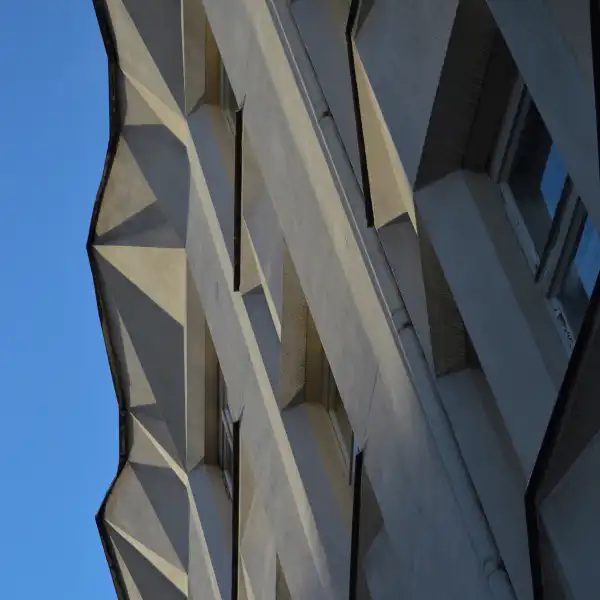Rondocubist route
Kingdom of arches and national colours
Some perceive it as a symbol of a new nation, while others see it as a ghost of long-surpassed architecture teetering on the edge of kitsch. In reality, the style known as rondocubism, also referred to as national decorativism , Czech Art Deco, or arched cubism, is characterized by plastic facades full of decorations and rounded edges. Rondocubism emerged in connection with the establishment of Czechoslovakia and can be seen as a reaction to the preceding period of Cubism. The architects of that time were intoxicated by the freedom of the new independent state and sought an architectural expression that would demonstrate the uniqueness of Czech culture. To create a purely national style, they drew inspiration from traditional patterns of folk architecture, which they complemented with a palette of national colors in subdued shades such as ochre, beige, or sienna. Although rondocubism was considered regressive by some experts at the time, it undoubtedly represented an important stage in Czech architecture, enchanting us to this day with its playfulness, vivid colors, and references to the heroic history of the Czech nation.
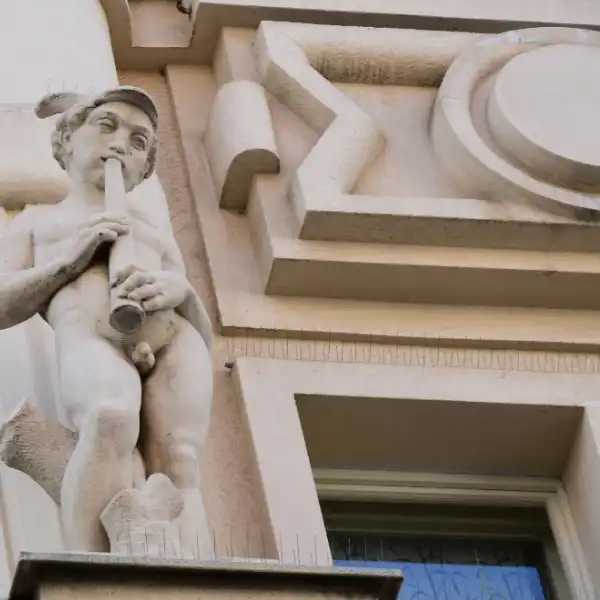
Duration:
40 minut
Number of stops:
6 + 7
Lenght:
2,9 km
MHD start:
Můstek
MHD end:
Lipanská
Rental apartment building on Jungmann Square
Architect: Rudolf Stockar
Year of completion: 1922
On the narrow Gothic plot at Jungmann Square, there stood a house since the time of Charles IV. The later neoclassical building, of which the ribbed vaults and staircase on the ground floor have been preserved to this day, underwent several renovations over the centuries. The most significant transformation took place in the 1920s, according to Rudolf Stockar’s design. The proposal, prepared for the merchant Gustav Vinařský, was influenced by Rondocubism, which is particularly evident on the facade facing Jungmann Square.
The single-axis facade is bordered on the sides by convex red pilasters and horizontally divided by a composition of cornices and window sills of the same color. The most distinctive elements are the rounded bay window on the fourth floor and the arched gable at the very top of the building. Over the years, the ground floor has been modified, and further changes to the house have been ongoing. Nevertheless, this protected monument still represents a high-quality example of Czech Rondocubism.
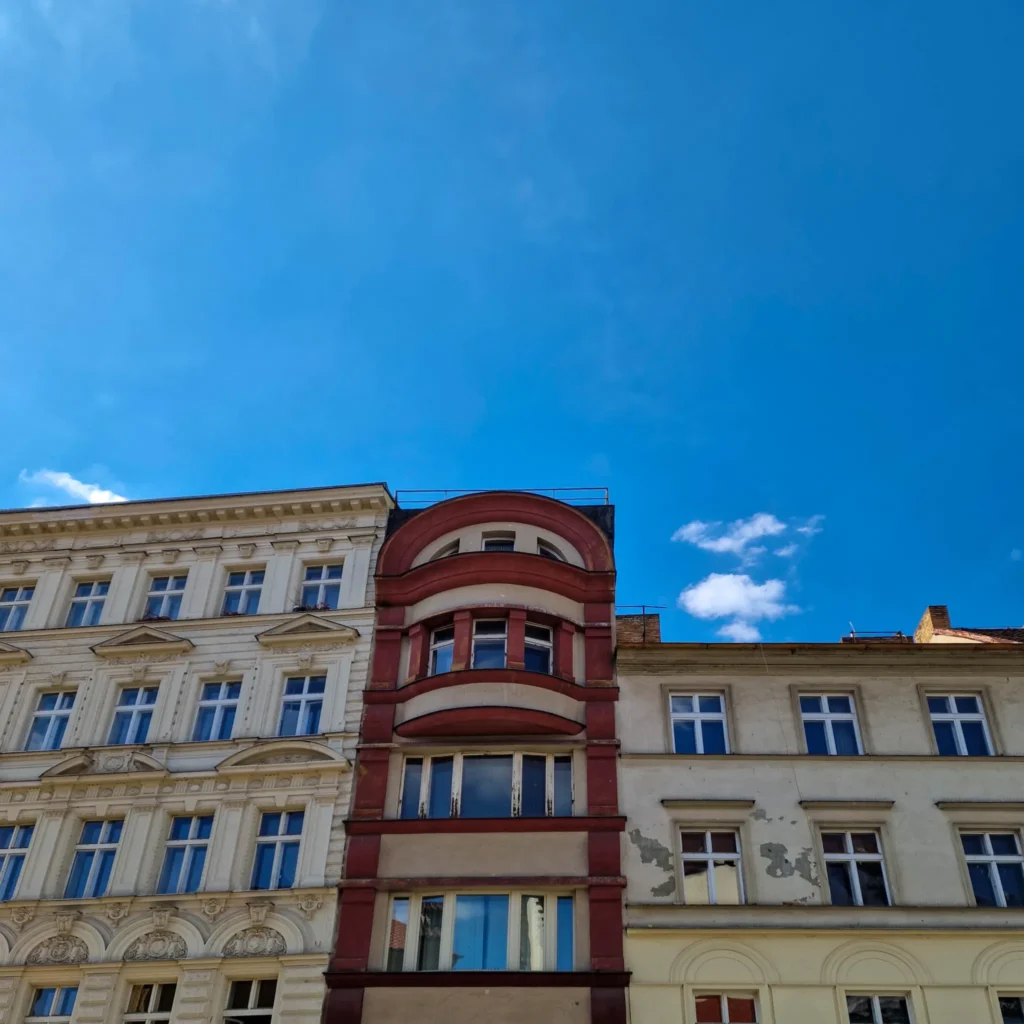
Riunione Adriatica di Sicurtà Insurance / Adria Palace
Architect: Pavel Janák, Josef Zasche
Year of completion: 1924
Adria Palace is a prime example of Czech Art Deco, even though it doesn’t entirely draw from Czech architecture. The Italian insurance company Riunione Adriatica di Sicurtà chose the location, where the Thun-Hohenstein Palace previously stood, for its new headquarters and entrusted the project to architect Josef Zasch. Later, Pavel Janák joined him with a design for the famous facade filled with Rondocubist details, such as arched and triangular cornices, or pilasters with stylized flowers. The relationship between Italy and the Czech Republic is symbolized by the elevated entrance with side sculptures depicting Trieste and Prague, created by sculptor Karel Dvořák.
The central passage is dominated by a circular square and the insurance company hall, featuring a clock adorned with sculptural decorations by Bohumil Kafka. At the opposite end of the passage, there is the entrance to the renowned Adria Café, which has recently been meticulously restored to its original appearance, and its rooftop terrace offers a beautiful view of Národní třída.
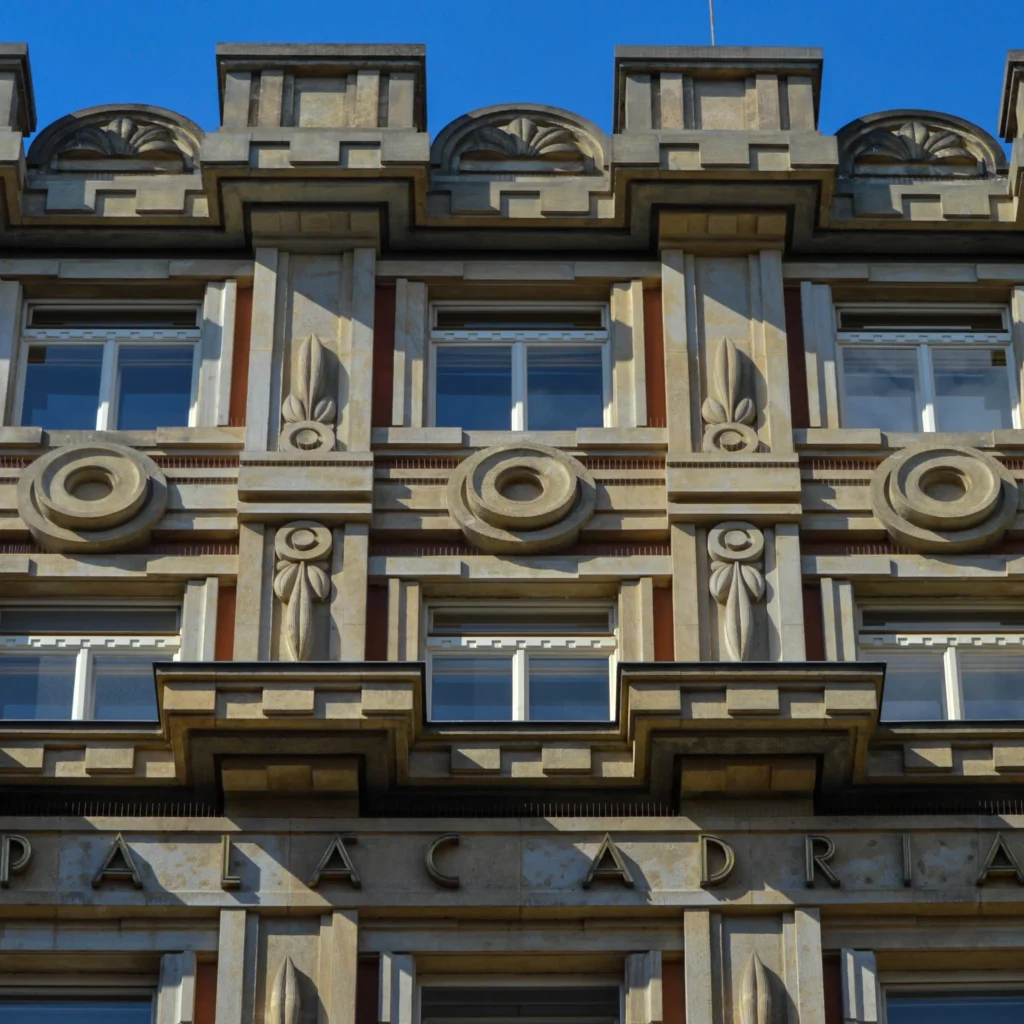
U Myšáka house
Architect: Otto Ehlen, Josef Čapek, Josef Gočár
Year of completion: 1922
In the architectural development of Vodičkova Street, the prominent building U Myšáka plays a significant role. It was originally built as a Neo-Renaissance structure in 1883. However, its current Rondocubist form dates back to the First Republic era. The owner of the complex, the renowned Czech confectioner František Myšák, established his namesake confectionery “Myšák” here, which counted famous guests such as Ema Destinová, Oldřich Nový, and President Masaryk among its regular guests.
The design of the Rondocubist facade from 1922 is attributed to the builder Josef Čapek, although it is likely that Josef Gočár also participated in its development. The result is truly a masterpiece of the national Art Deco style, adorned with characteristic arches, cylinders, and triangles. The entire facade is unified by a decorated corbelled cornice, a pair of bay windows, a high order of pilasters, and interlocking window arches. The color scheme, referencing the national colors of red and white, further enhances the unity. Parts of the interior, including the confectionery itself, were created in the same style. However, only fragments of the original Rondocubist decoration have survived to this day.

Radiopalace
Architect: Alois Dryák
Year of completion: 1925
The voluminous six-story building of Radiopalace spans across three streets in Prague: Vinohradská, Sázavská, and Blanická. At first glance, it blends in with the surrounding architecture, but upon closer examination, its intricate adorned facade stands out, representing the typical Czech arch style. The building consists of three wings forming a U shape, with an integrated two-story wing set lower. Alois Dryák, an architect known for his diverse designs in various styles and purposes throughout his career (such as the Art Nouveau Hotel Meran on Wenceslas Square, the original form of Strahov Stadium, and his involvement in the architectural work on the František Palacký Monument in 1912), became the architect of Radiopalace.
Since its establishment in the 1920s, Radiopalace has been a gathering place and venue for cultural events. This tradition continues to this day, thanks to the two social halls that are mostly available for rent.

Švehla hall
Architect: Jan Chládek
Year of completion: 1925
The strikingly colorful building of Švehlova Hall bears the name of Antonín Švehla, a politician from the First Czechoslovak Republic who contributed to the city’s architectural development. The construction of this grand six-story building, which includes a former cinema (now the „Venuše ve Švehlovce“ theater within the inner courtyard), was funded through a mortgage from the state, a lottery, and a cooperative share worth 500 Czech crowns, which each parent of an accommodated student had to pay. At the time, it was one of the most modern buildings of its kind in Europe. Nearly all original details have been preserved, including the Rondocubist facade, staircase, corridors, and rooms. Above the main entrance, there are four caryatids symbolizing the seasons, created by František Úprka.
In the 1950s, a new wing in the style of Socialist Realism was added to the Rondocubist building, adorned with period sgraffito. The hall has a rich history in terms of important events. Students were arrested here after anti-fascist demonstrations in 1939, and during the war, the hall was even occupied by fascists. During the communist era, it was called “5. května” and came under state administration, later transferring to the administration of Charles University.

City Telephone Exchange
Architect: Bohumír Kozák
Year of completion: 1926
The yellow building of the former telephone exchange was the first house built in Žižkov after the establishment of Greater Prague. It became the center for all telephone calls and also served as the headquarters of the postal office. The reliefs on the top of the entrance portals, along with other sculptural decorations, created by Ladislav Kofránek, reference these two functions. Although this building with its adorned geometric facade is now vacant, it used to be in almost continuous operation. Employees had the option to live or use the communal swimming pool within the building. The interior was dominated by a 30 meter long and 15 meter wide hall, where 82 switchboards were located. During that time, antenna wires were stretched between the two towers. The building’s history also includes the beginnings of Czechoslovak Television, as in the 1930s, it housed the television institute responsible for developing television signals. The Rondocubist exchange served as the offices for Telecom from the 1980s, and it has been vacant since 2010.
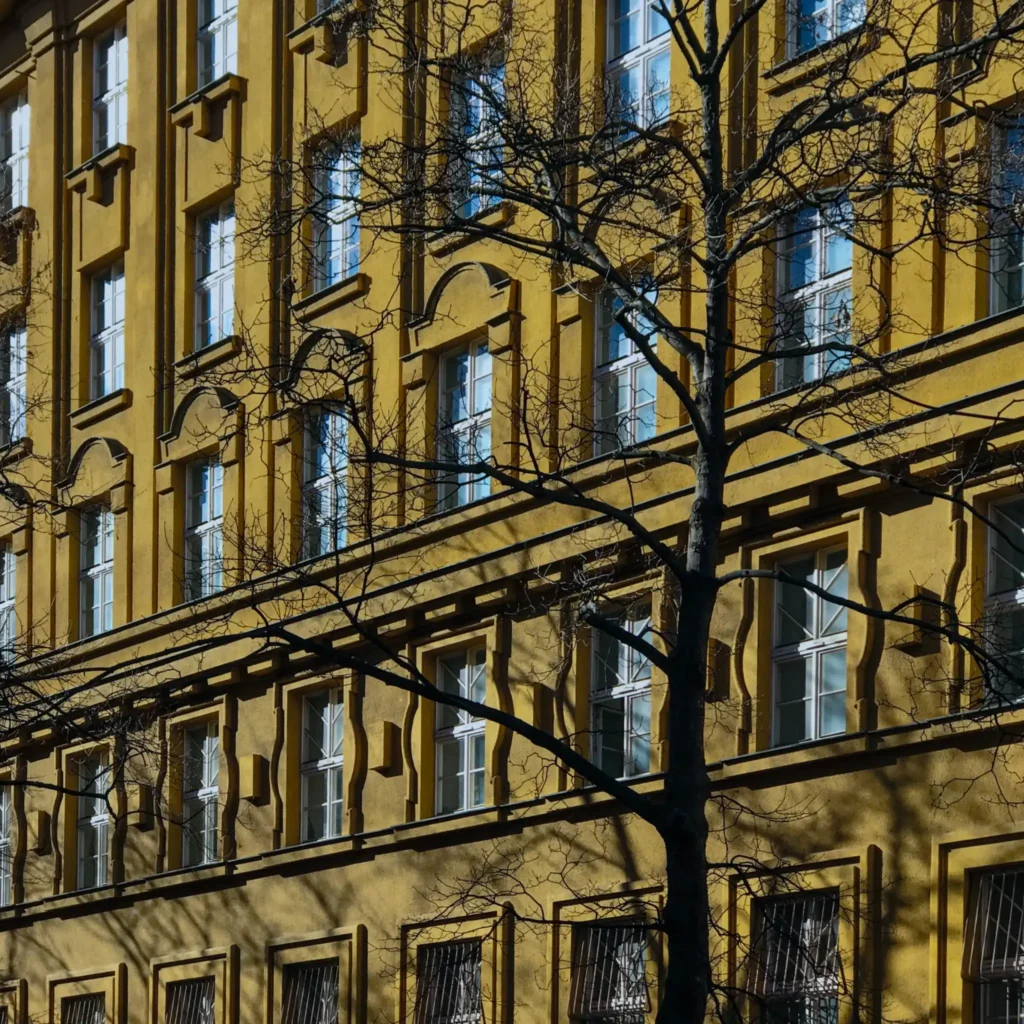
Zastávky mimo trasu

Akropolis palace
Architect: Rudolf Svoboda
Year of completion: 1927
The six-story corner building in Žižkov was originally intended, much like Radiopalace, to serve as a venue for cultural events. Rudolf Svoboda became both the owner and architect of the building, aiming to create a structure in close proximity to Královské Vinohrady that would house a theater hall, a café, and residential spaces for the upper middle class. However, due to financial reasons, he had to sell the building shortly after its opening, and over the years, the palace underwent many changes. The most significant transformation occurred in the 1990s when a major reconstruction took place. The restaurant was reopened, followed by a multifunctional hall that now serves theater, music, and other productions.
The facade of Akropolis Palace features an unconventional olive green color, complemented by Rondocubist shapes and blue, yellow, and red details.
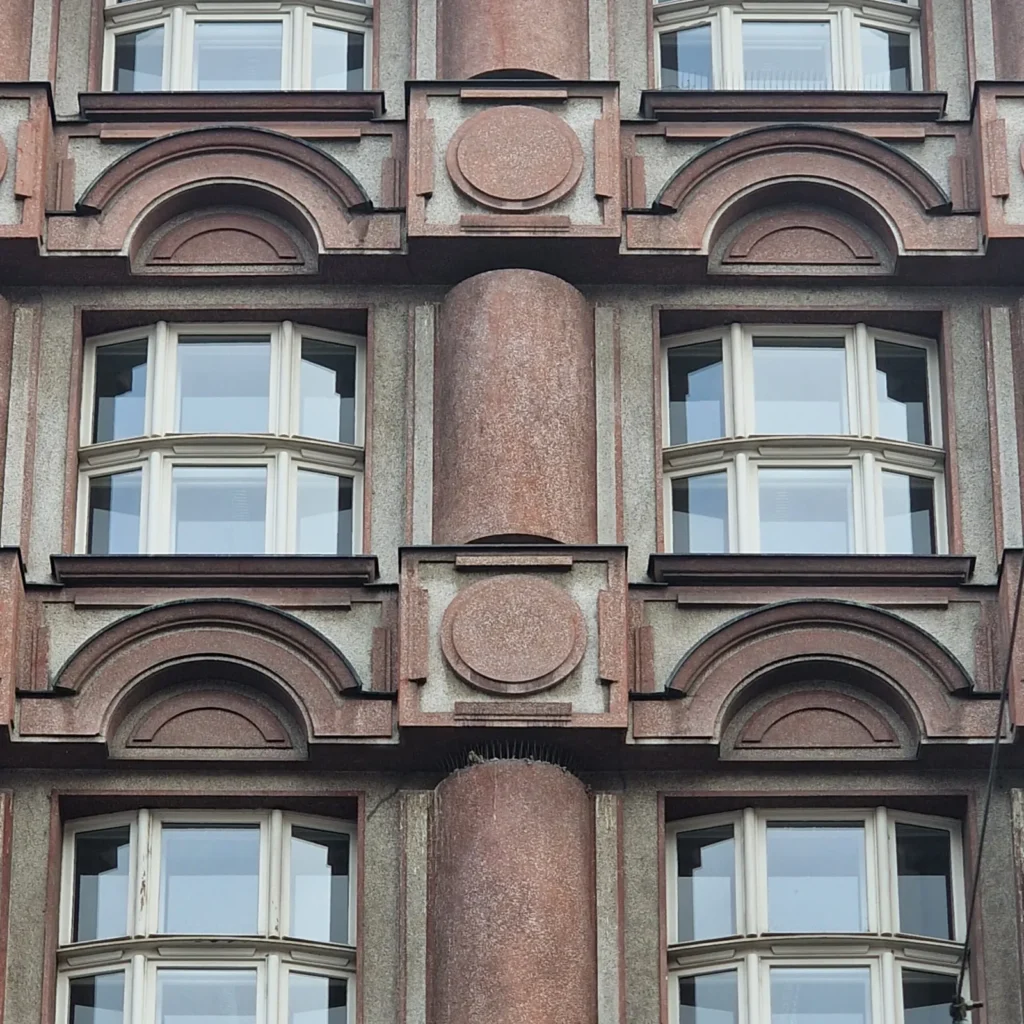
The Czechoslovak legion bank
Architect: Josef Gočár
Year of completion: 1923
The Czechoslovak legion bank or Legiobank, began managing the savings of the legionnaires shortly after World War I, which were accumulated during the Russian campaign. Initially, it was located in the Štefánik barracks and then in the hotel U Saského dvora. However, in 1923, it moved to its new Rondocubist building. The architecture of the bank incorporates certain cubist elements, which were softened and rounded in line with Slavic tradition. The relatively narrow yet massive facade facing Na Poříčí Street may give the impression of being assembled like a child’s puzzle. Arches, cylinders, and circular plates are complemented by visual art in the form of four heads by Jan Štursa, representing the most significant battlefields where our legionnaires fought, such as Zborov or Vouziers in France. Above these heads, there is a long frieze by Otto Gutfreund depicting the post-war return of the legionnaires and their future lives. The sculptural facade, executed in subdued national colors, unusually extends above the vertical gable of the neighboring building U Zlatého slunce.
Architect Josef Gočár conceived the interior of the building as a gesamtkunstwerk, or a comprehensive work of art, where the design extends to the smallest details. He himself designed a range of furniture elements for the building, including colorful railings and various types of lighting fixtures. This is best exemplified by the bank hall itself – from the glazed trilobite skylight to the adorned series of bank counters and the red-white mosaic on the floor. It is no wonder that Rondocubism is often referred to as the style of Legiobank.

Rental house Růžová
Architect: Bohumír Kozák
Year of completion: 1922
Růžová Street in Nové Město is very narrow, so not everyone passing by may notice the house with its Rondocubist facade adorned with rounded details. Originally, there was a Neoclassical house on the plot, built in 1841 by architect Karel Duchoslav. However, at the beginning of the 1920s, it was replaced with a newly built semi-detached house in the spirit of national decorativism, following a request from the banking office of the Ministry of Finance. Unlike other buildings from this period, it is not vibrant in colors and is executed solely in cream-white. However, the facade itself, particularly the high order of the central axis, is filled with Rondocubist details – sculptural balcony consoles, parapets with circular motifs, and entranceways topped with semicircular pediments and a series of undercut cornices. The name of the architect is even incorporated into the facade, engraved on the ground floor at the right end of the outer pillar. The interior of the building is also designed in the same style, featuring beautiful stucco decoration on the walls and ceiling, stone-clad staircase, and terrazzo mosaic flooring.

The Red Houses
Architect: Rudolf Hrabě
Year of completion: 1922
One of the possible solutions to the housing crisis after the end of World War I was the concept of collective living. This innovative idea was introduced to the Czech public by Tomáš Garrigue Masaryk in his lectures on American collective and apartment buildings in 1905. However, it truly took shape in the early 1920s when a complex of nine rental buildings was created according to the design by architect Rudolf Hrabět. The “Red Houses” were originally intended for workers, offering them a collective dining room, nursery, kindergarten, and gymnasium. However, a significant portion of the apartments ended up being occupied by office workers who found the low worker’s standard of living unsuitable. This may have been an unsuccessful attempt at housing collectivization, but it remains an architecturally valuable construction in the Rondocubist style, characterized by the use of red and ochre colors, intricate facade detailing, and prominent projecting cornices and pilasters. The brick fencing, which creates a unified whole, is also architecturally significant. In terms of interiors, the original Rondocubist decoration has been preserved mainly in the common areas of the buildings, such as the staircases with geometrically designed railings.
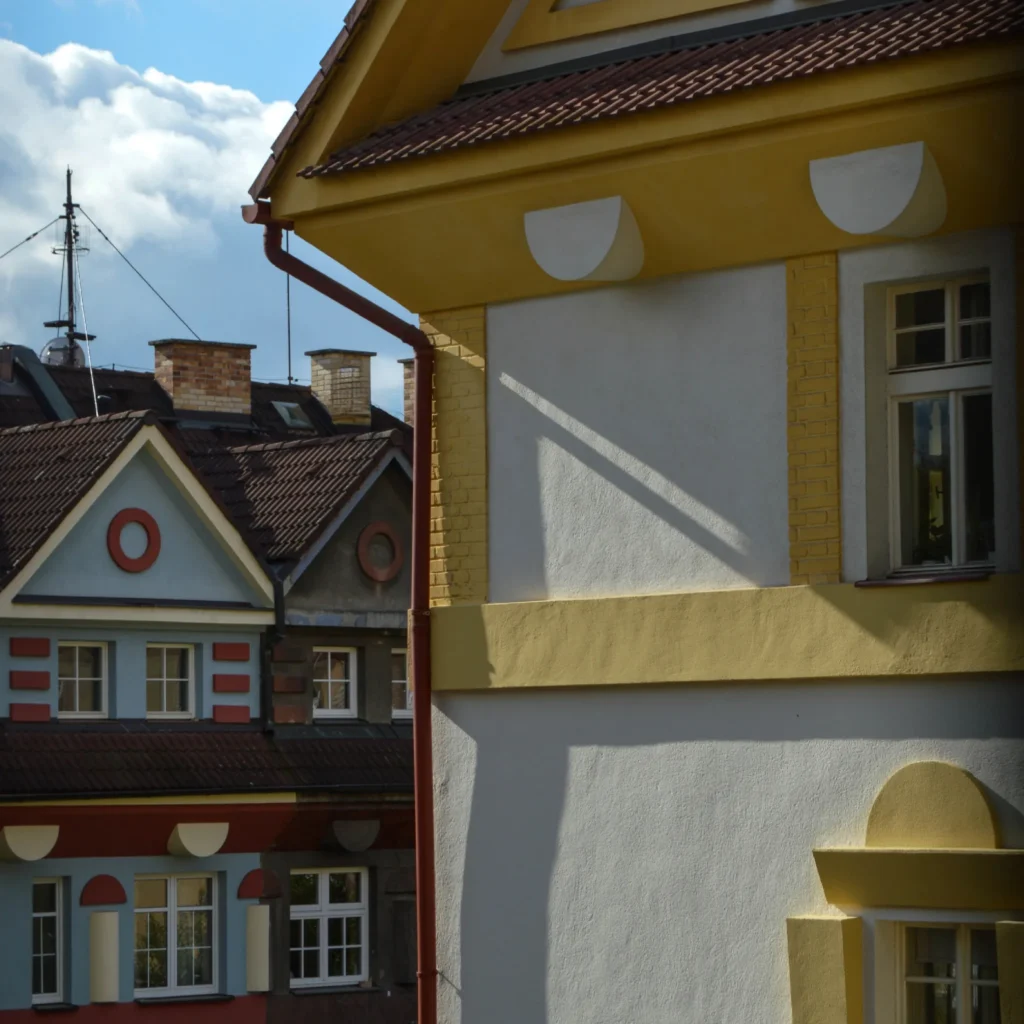
Svoboda colony
Architect: František Albert Libra
Year of completion: 1924
The First Republic colony in Vinohrady is an unmissable showcase of Rondocubist villas. A total of 16 detached houses and 17 semi-detached villas were built here by the order of the Svépomoc Cooperative. Among the buildings of various colors, there is also the personal villa of the architect responsible for the urbanism of the entire colony and the design of individual house types, František Albert Libra. However, not many details of his own villa at Chorvatská 6 can be recognized since it is completely overgrown with ivy. Although the individual buildings in the colony have slight differences, they are all united by the unified style of Czech Art Deco, characterized by distinctive ornaments on the facades and unconventional fences.
Among the authentically preserved and renovated villas and houses, there is one with a tarnished fate. Its owner embarked on an illegal demolition, which was temporarily halted, but to this day, a ruin stands in the middle of the colony, serving as a reminder of human thoughtlessness.

Teachers’ Houses in Holešovice
Architect: Otakar Novotný
Year of completion: 1924
The truly talented and versatile architect Otakar Novotný explored many architectural styles throughout his long career – from Art Nouveau to pre-war modernism and pure functionalism. Therefore, it is not surprising that he also delved into the realm of Rondocubism. One notable result of this phase in his work is the apartment building constructed between 1923 and 1924 for the Cooperative for the Construction of Teachers’ Houses.
The ochre-gray facade of the building has a clearly rhythmical structure in its main four floors. The architect played with volumes, creating the illusion that a composition of nine rounded cylinders and a series of arched cornices emerge from the flat surface of the facade. The top setback floor, separated by a cornice, is not as dynamically articulated, but it completes the building with its characteristic semi-circular windows. The entrance from the street is partially covered by a massive cornice supported by six conical columns.
The rounded motifs intertwine into the interior of the building as well, particularly in the shared stairwell corridor, which is adorned with Rondocubist-style stucco decorations.
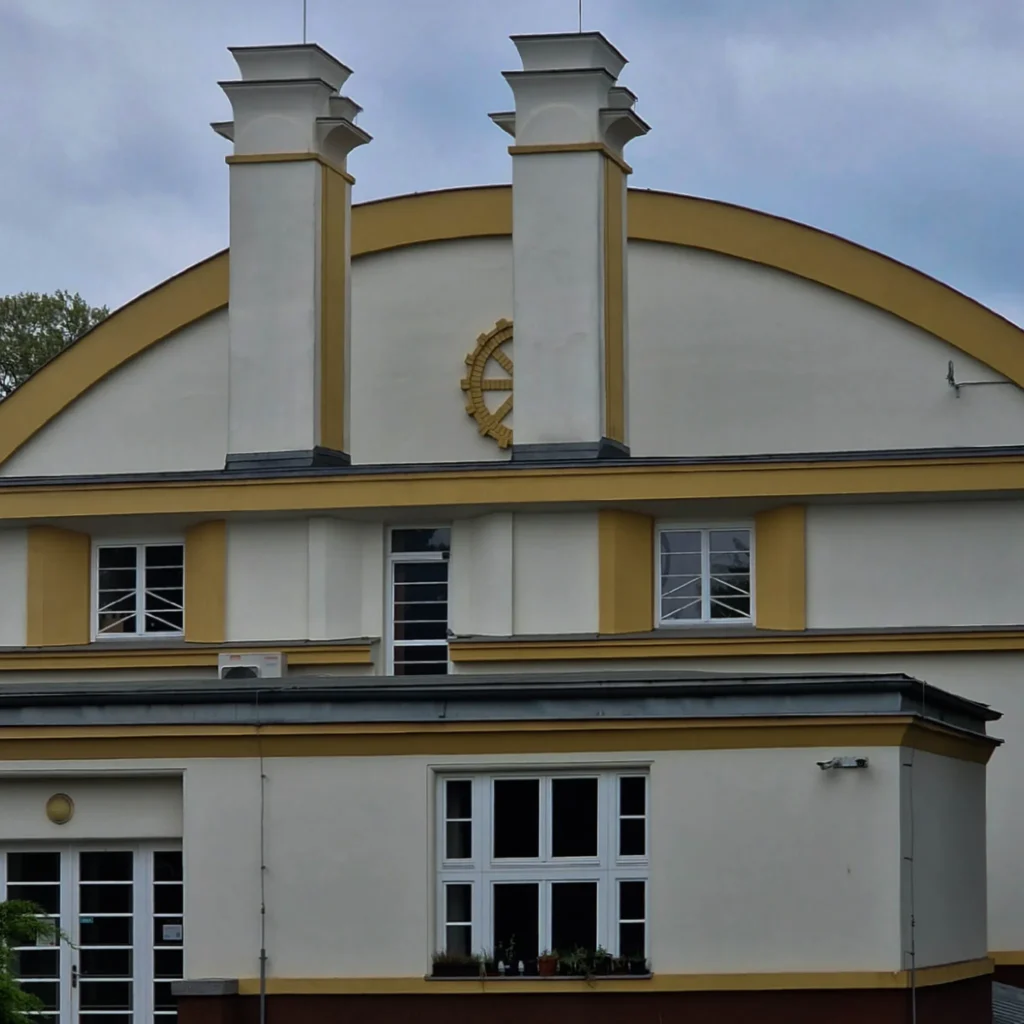
The Bruska Pumping Station
Architect: Bohumír Hollmann, Jaroslav Žofka, Luděk Řehák, Josef Němec
Year of completion: 1930
The Bruska Pumping Station was built shortly after World War I to address the acute water shortage in the Letná and Hradčany areas. While the construction had been considered before the war, it was not completed until 1930. The interior is filled with various systems of pipes and pumps, meeting not only the utilitarian needs of operation but also surprising with inventive architecture. The exterior is characterized by the prominent motif of a gear wheel and a pair of chimneys displaying the stylistic features of Cubism and Rondocubism. In contrast, the interior is dominated by a gleaming white reinforced concrete vaulted ceiling.
In addition to the pumping hall, the station is equipped with two water reservoirs and a workshop building known as the sculptor Bohumil Kafka’s studio, or Kafkárna. In this originally makeshift building from 1932, Kafka prepared the equestrian statue of Žižka, which still adorns the monument on Vítkov Hill. After the revolution, the premises were taken over by the Prague UMPRUM led by sculptor Kurt Gebauer, and today it serves as the Center for Art and Ecology. The entire complex, including Kafkárna, is surrounded by a unified fence with semi-circular motifs and a pair of gates with protruding rectangular panels.

Garden route

Feminist route
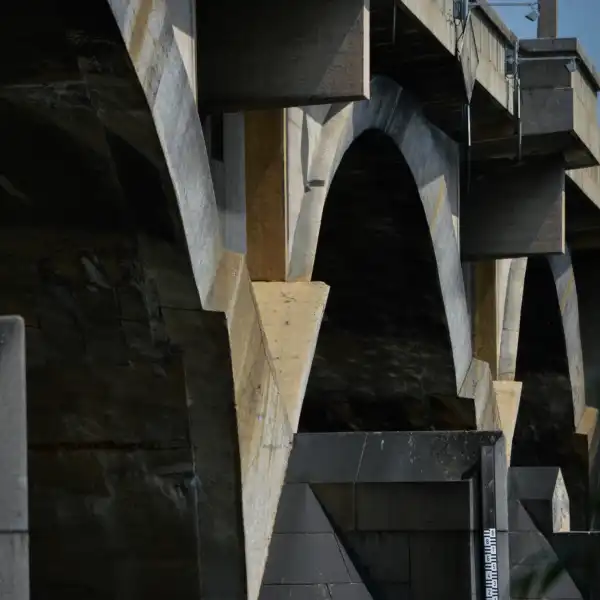
Bridge Route
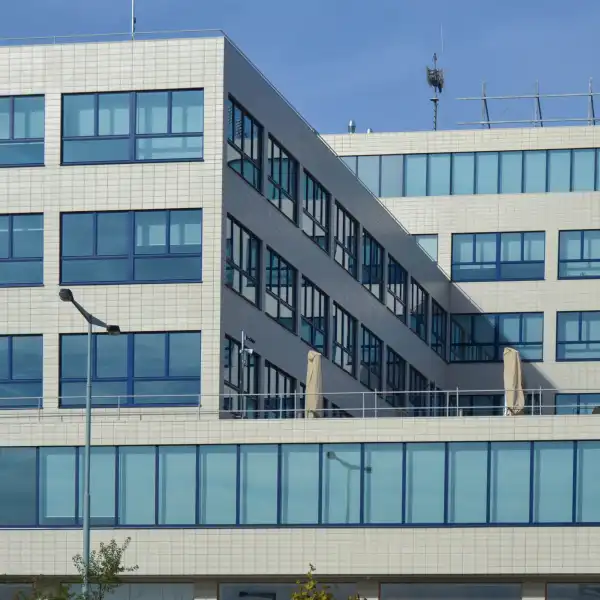
Functionalist Route

Passage Route
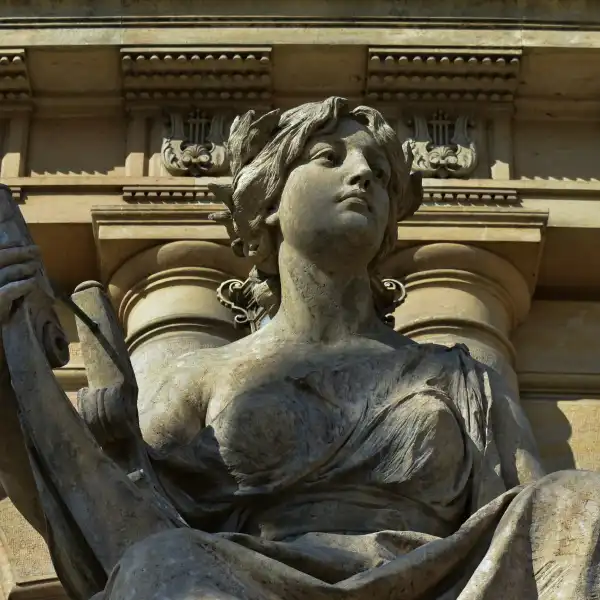
Music Route

Church Route (1930s)

Prager’s Route
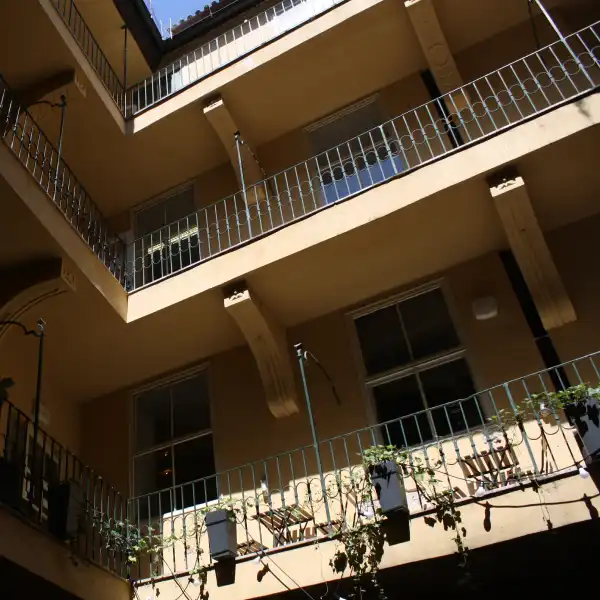
Inner Courtyard Route

Glass Route

Empty Route

Literary Route

Brutalist route
